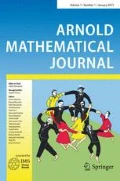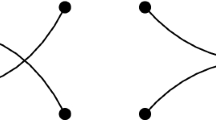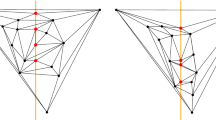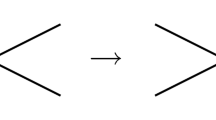Abstract
We present a simplified exposition of some classical and modern results on graph drawings in the plane. These results are chosen so that they illustrate some spectacular recent higher-dimensional results on the border of geometry, combinatorics and topology. We define a \({\mathbb {Z}}_2\) valued self-intersection invariant (i.e. the van Kampen number) and its generalizations. We present elementary formulations and arguments accessible to mathematicians not specialized in any of the areas discussed. So most part of this survey could be studied before textbooks on algebraic topology, as an introduction to starting ideas of algebraic topology motivated by algorithmic, combinatorial and geometric problems.










Similar content being viewed by others
Notes
Examples are definition of the mapping degree [Matoušek 2008, Sect. 2.4], [Skopenkov 2020, Sect. 8] and definition of the Hopf invariant via linking, i.e., via intersection [Skopenkov 2020, Sect. 8]. Importantly, ‘secondary’ not only ‘primary’ invariants allow interpretations in terms of framed intersections; for a recent application see [Skopenkov 2017a].
The ‘minimal generality’ principle (to introduce important ideas in non-technical particular cases) was put forward by classical figures in mathematics and mathematical exposition, in particular by V. Arnold. Cf. ‘detopologization’ tradition described in [Matoušek et al. 2012, Historical notes in Sect. 1].
The common term for this notion is a graph without loops and multiple edges or a simple graph.
See proof in [Skopenkov 2018c, Sect. 1.6]. Proposition 1.1.2 and [Skopenkov 2018c, 1.6.1] are not formally used in this paper. However, they illustrate by two-dimensional examples how boolean functions appear in the study of embeddings. This is one of the ideas behind recent higher-dimensional NP-hardness Theorem 3.2.3.b.
We do not require that ‘no isolated vertex lies on any of the segments’ because this property can always be achieved.
Rigorous definition of the notion of algorithm is complicated, so we do not give it here. Intuitive understanding of algorithms is sufficient to read this text. To be more precise, the above statement means that there is an algorithm for calculating the function from the set of all graphs to \(\{0,1\}\), which maps graph to 1 if the graph is linearly realizable in the plane, and to 0 otherwise. All other statements on algorithms in this paper can be formalized analogously.
Then any two of the polygonal lines either are disjoint or intersect by a common end vertex. We do not require that ‘no isolated vertex lies on any of the polygonal lines’ because this property can always be achieved. See an equivalent definition of planarity in the beginning of Sect. 1.4.
Since for a planar graph with n vertices and e edges we have \(e \le 3n-6\) and since there are planar graphs with n vertices and e edges such that \(e=3n-6\), the ‘complexity’ in the number of edges is ‘the same’ as the ‘complexity’ in the number of vertices.
The number \(L\cdot P\) is defined in Sect. 1.5.4.
This version of the Stokes theorem shows that the complement to L has a Möbius–Alexander numbering, i.e. a ‘chess-board coloring by integers’ (so that the colors of the adjacent domains are different by \(\pm 1\) depending on the orientations; the ends of a polygonal line P have the same color if and only if \(L\cdot P=0\)).
See more in [https://en.wikipedia.org/wiki/Winding_number].
This is an elementary interpretation in the spirit of [Schöneborn 2004, Schöneborn and Ziegler 2005] of the r-tuple algebraic intersection number \(fD^{n_1}\ldots fD^{n_r}\) of a general position map \(f:D^{n_1}\sqcup \cdots \sqcup D^{n_r}\rightarrow {\mathbb {R}}^2\), where \(n_1,\ldots ,n_r\subset \{0,1,2\}\) and \(n_1+\cdots +n_r=2r-2\) [Mabillard and Wagner 2015, Sect. 2.2]. This agrees with [Mabillard and Wagner 2015, Sect. 2.2] by [Mabillard and Wagner 2015, Lemma 27.b]. For a degree interpretation see [Skopenkov 2018c, Assertion 2.5.4].
This is the \(d(r-1)\)-skeleton of the simplicial r-fold deleted product of K. Cf. [Skopenkov 2018a, Sect. 1.4].
This agrees up to sign with the definition of [Mabillard and Wagner 2015, Lemma 41.b] because by [Mabillard and Wagner 2015, (13) in p. 17] \(\varepsilon _{2,2,\ldots ,2,0}\) is even and \(\varepsilon _{2,2,\ldots ,2,1,1}\) is odd.
The r-fold intersection cocycle depends on an arbitrary choice of orientations, but the triviality condition defined below does not.
Here NP-hardness means that using a devise which solves this problem EMBED(k,d) at 1 step, we can construct an algorithm which is polynomial in n and which recognizes if a boolean function of n variables is identical zero, the function given as a disjunction of some conjunctions of variables or their negations (e.g. \(f(x_1,x_2,x_3,x_4)=x_1x_2{\overline{x}}_3\vee {\overline{x}}_2x_3x_4\vee {\overline{x}}_1x_2x_4\)). M. Tancer suggests that it is plausible to approach the conjecture the same way as in [Matoušek et al. 2011, Skopenkov and Tancer 2017]. Namely, one can possibly triangulate the gadgets in advance and glue them together so that the ‘embeddable gadgets’ would be linearly embeddable with respect to the prescribed triangulations. By using the same triangulation on gadgets of same type, one can achieve polynomial size triangulation. Realization of this idea should be non-trivial.
References
Arnold, V.I.: Topological invariants of plane curves and caustics, University Lecture Series, vol. 5. American Mathematical Society, Providence (1995)
Avvakumov, S., Karasev, R.: Envy-free division using mapping degree (2019). arXiv:1907.11183
Avvakumov, S., Karasev, R., Skopenkov, A.: Stronger counterexamples to the topological Tverberg conjecture. (2019a). arxiv:1908.08731 (submitted)
Avvakumov S, Mabillard, I., Skopenkov, A., Wagner, U.: Eliminating higher-multiplicity intersections, III. Codimension 2, Israel J. Math. (to appear). (2019b). arxiv:1511.03501
Bajmóczy, E.G., Bárány, I.: On a common generalization of Borsuk’s and Radon’s theorem. Acta Math. Acad. Sci. Hungar. 34(3), 347–350 (1979)
Bárány, I., Shlosman, S.B., Szűcs, A.: On a topological generalization of a theorem of Tverberg. J. Lond. Math. Soc. (II. Ser.) 23, 158–164 (1981)
Bárány, I., Blagojević, P.V.M., Ziegler, G.M.: Tverberg’s theorem at 50: extensions and counterexamples. Not. AMS 63(7), 732–739 (2016)
Blagojevič, P.V.M., Ziegler, G.M.: Beyond the Borsuk–Ulam theorem: the topological Tverberg story. In: Loebl, M., Nešetřil, J., Thomas, R. (eds.) A Journey Through Discrete Mathematics, pp. 273–341, (2016). arXiv:1605.07321v2
Blagojević, P.V.M., Frick, F., Ziegler, G.M.: Tverberg plus constraints. Bull. Lond. Math. Soc. 46(5), 953–967 (2014). arXiv: 1401.0690
Blagojević, P.V.M., Matschke, B., Ziegler, G.M.: Optimal bounds for the colored Tverberg problem. J. Eur. Math. Soc. 17(4), 739–754 (2015). arXiv:0910.4987
Boyer, J.M., Myrvold, W.J.: On the cutting edge: simplified \(O(n)\) planarity by edge addition. J. Graph Alg. Appl. 8(3), 241–273 (2004)
Čadek, M., Krčál, M., Vokřínek, L.: Algorithmic solvability of the lifting-extension problem (2019). arXiv:1307.6444
Chernov, A., Daynyak, A., Glibichuk, A., Ilyinskiy, M., Kupavskiy, A., Raigorodskiy, A., Skopenkov, A.: Elements of Discrete Mathematics As a Sequence of Problems (in Russian), MCCME, Moscow (2016). http://www.mccme.ru/circles/oim/discrbook.pdf. Accessed 7 Nov 2019
de Mesmay, A., Rieck, Y., Sedgwick, E., Tancer, M.: Embeddability in \({\mathbb{R}}^{3}\) is NP-hard (2019). arXiv:1708.07734
Enne, A., Ryabichev, A., Skopenkov, A., Zaitsev, T.: Invariants of graph drawings in the plane (2019). http://www.turgor.ru/lktg/2017/6/index.htm. Accessed 7 Nov 2019
Filakovsky, M., Wagner, U., Zhechev, S.: Embeddability of simplicial complexes is undecidable. Oberwolfach reports (2019) (to appear)
Fokkink, R.: A forgotten mathematician. Eur. Math. Soc. Newsl. 52, 9–14 (2004)
Freedman, M.H., Krushkal, V.S., Teichner, P.: Van Kampen’s embedding obstruction is incomplete for 2-complexes in \({{\mathbb{R}}^{4}}\). Math. Res. Lett. 1, 167–176 (1994)
Frick, F.: Counterexamples to the topological Tverberg conjecture, Oberwolfach reports (2015). arXiv:1502.00947
Frick, F.: On affine Tverberg-type results without continuous generalization (2017). arXiv:1702.05466
Gromov, M.: Singularities, expanders and topology of maps. Part 2: from combinatorics to topology via algebraic isoperimetry. Geom. Funct. Anal. 20(2), 416–526 (2010)
Gross, J.L., Rosen, R.H.: A linear time planarity algorithm for 2-complexes. J. ACM 26(4), 611–617 (1979)
Hopcroft, J., Tarjan, R.E.: Efficient planarity testing. J. Assoc. Comput. Mach. 21(4), 549–568 (1974)
Khoroshavkina, N.: A simple characterization of graphs of cutwidth (2019). arXiv:1811.06716
Lin, Y., Yang, A.: On 3-cutwidth critical graphs. Discret. Math. 275, 339–346 (2004)
Lovasz, L., Schrijver, A.: A Borsuk theorem for antipodal links and a spectral characterization of linklessly embeddable graphs. Proc. AMS 126(5), 1275–1285 (1998)
Mabillard, I., Wagner, U.: Eliminating Higher-Multiplicity Intersections, I. A Whitney trick for Tverberg-Type problems (2015). arXiv:1508.02349
Mabillard, I., Wagner, U.: Eliminating Higher-Multiplicity Intersections, II. The deleted product criterion in the \(r\)-metastable range (2016). arXiv:1601.00876
Matoušek, J.: Using the Borsuk-Ulam theorem: lectures on topological methods in combinatorics and geometry. Springer, Berlin (2008)
Matoušek, J., Tancer, M., Wagner, U.: Hardness of embedding simplicial complexes in \({\mathbb{R}}^{d}\). J. Eur. Math. Soc. 13(2), 259–295 (2011). arXiv:0807.0336
Matoušek, J., Tancer, M., Wagner, U.: A geometric proof of the colored Tverberg theorem. Discret. Comp. Geom. 47(2), 245–265 (2012). arXiv:1008.5275
Matoušek, J., Sedgwick, E., Tancer, M., Wagner, U.: Embeddability in the 3-sphere is decidable. J. ACM 65(1), 1–49 (2018). arXiv:1402.0815
Özaydin, M.: Equivariant maps for the symmetric group, unpublished (2019). http://minds.wisconsin.edu/handle/1793/63829. Accessed 7 Nov 2019
Sarkaria, K.S.: A generalized Van Kampen-Flores theorem. Proc. Am. Math. Soc. 111, 559–565 (1991)
Schöneborn, T.: On the topological Tverberg theorem (2004). arXiv:math/0405393
Schöneborn, T., Ziegler, G.: The topological Tverberg Theorem and winding numbers. J. Combin. Theory Ser. A 112(1), 82–104 (2005). arXiv:math/0409081
Shlosman, S.: Topological Tverberg theorem: the proofs and the counterexamples. Russ. Math. Surv. 73(2), 175–182 (2018). arXiv:1804.03120
Skopenkov, M.: Embedding products of graphs into Euclidean spaces. Fund. Math. 179, 191–198 (2003). arXiv:0808.1199
Skopenkov, A.: A new invariant and parametric connected sum of embeddings. Fund. Math. 197, 253–269 (2007). arXiv:math/0509621
Skopenkov, A.: Embedding and knotting of manifolds in Euclidean spaces. Lond. Math. Soc. Lect. Notes 347, 248–342 (2008). arXiv:math/0604045
Skopenkov, A.: Realizability of hypergraphs and Ramsey link theory. (2014). arxiv:1402.0658
Skopenkov, A.: Eliminating higher-multiplicity intersections in the metastable dimension range (2017a). arxiv:1704.00143
Skopenkov, A.: On the Metastable Mabillard–Wagner Conjecture (2017b). arxiv:1702.04259
Skopenkov, A.: A user’s guide to the topological Tverberg Conjecture, Russian Math. Surveys, 73:2 (2018a), 323–353. Earlier version: arXiv:1605.05141v4. §4 available as A. Skopenkov, On van Kampen-Flores, Conway-Gordon-Sachs and Radon theorems. arXiv:1704.00300
Skopenkov, A.: Stability of intersections of graphs in the plane and the van Kampen obstruction. Topol. Appl. 240, 259–269 (2018b). arXiv:1609.03727
Skopenkov, A.: Invariants of graph drawings in the plane. Full author’s version (2018c). arXiv:1805.10237
Skopenkov, A.: Algebraic topology from algorithmic viewpoint, draft of a book, mostly in Russian (2019). http://www.mccme.ru/circles/oim/algor.pdf. Accessed 7 Nov 2019
Skopenkov, A.: Algebraic topology from geometric viewpoint (in Russian), MCCME, Moscow, 2nd edition (2020). http://www.mccme.ru/circles/oim/obstruct.pdf. Accessed 7 Nov 2019
Skopenkov, A., Tancer, M.: Hardness of Almost Embedding Simplicial Complexes in \(R^{d}\). Discret. Comp. Geom. (to appear) (2017). arXiv:1703.06305
Tamassia, R. (Ed.): Handbook of Graph Drawing and Visualization. Chapman and Hall/CRC (2019)
Thilikos, D.M., Serna, M., Bodlaender, H.L.: Cutwidth I: a linear time fixed parameter algorithm. J. Algorithms 56(1), 1–24 (2005)
Ummel, B.: The product of nonplanar complexes does not imbed in 4-space. Trans. Am. Math. Soc. 242, 319–328 (1978)
van Kampen, E.R.: Remark on the address of S. S. Cairns, in Lectures in Topology, pp. 311–313. University of Michigan Press, Ann Arbor (1941)
Volovikov, AYu.: On the van Kampen-Flores theorem. Math. Notes 59(5), 477–481 (1996a)
Volovikov, AYu.: On a topological generalization of the Tverberg theorem. Math. Notes 59(3), 324–326 (1996b)
Vučić, A., Živaljević, R.T.: Note on a conjecture of Sierksma. Discret. Comput. Geom. 9, 339–349 (1993)
Ziegler, G.M.: 3N colored points in a plane. Not. AMS 58(4), 550–557 (2011)
Author information
Authors and Affiliations
Corresponding author
Additional information
Publisher's Note
Springer Nature remains neutral with regard to jurisdictional claims in published maps and institutional affiliations.
Supported in part by the Russian Foundation for Basic Research Grant No. 19-01-00169 and by Simons-IUM Fellowship.
Rights and permissions
About this article
Cite this article
Skopenkov, A. Invariants of Graph Drawings in the Plane. Arnold Math J. 6, 21–55 (2020). https://doi.org/10.1007/s40598-019-00128-5
Received:
Revised:
Accepted:
Published:
Issue Date:
DOI: https://doi.org/10.1007/s40598-019-00128-5




